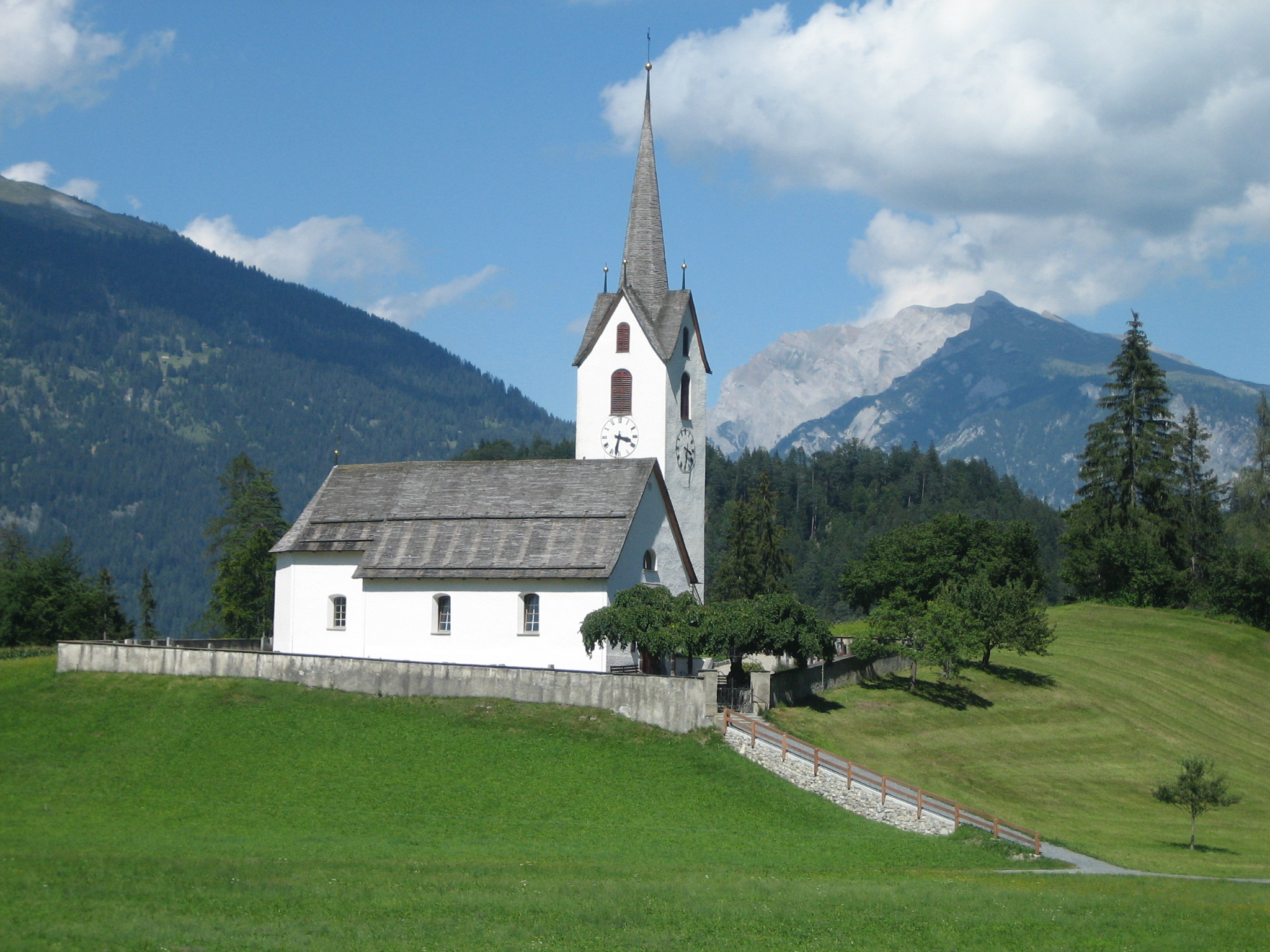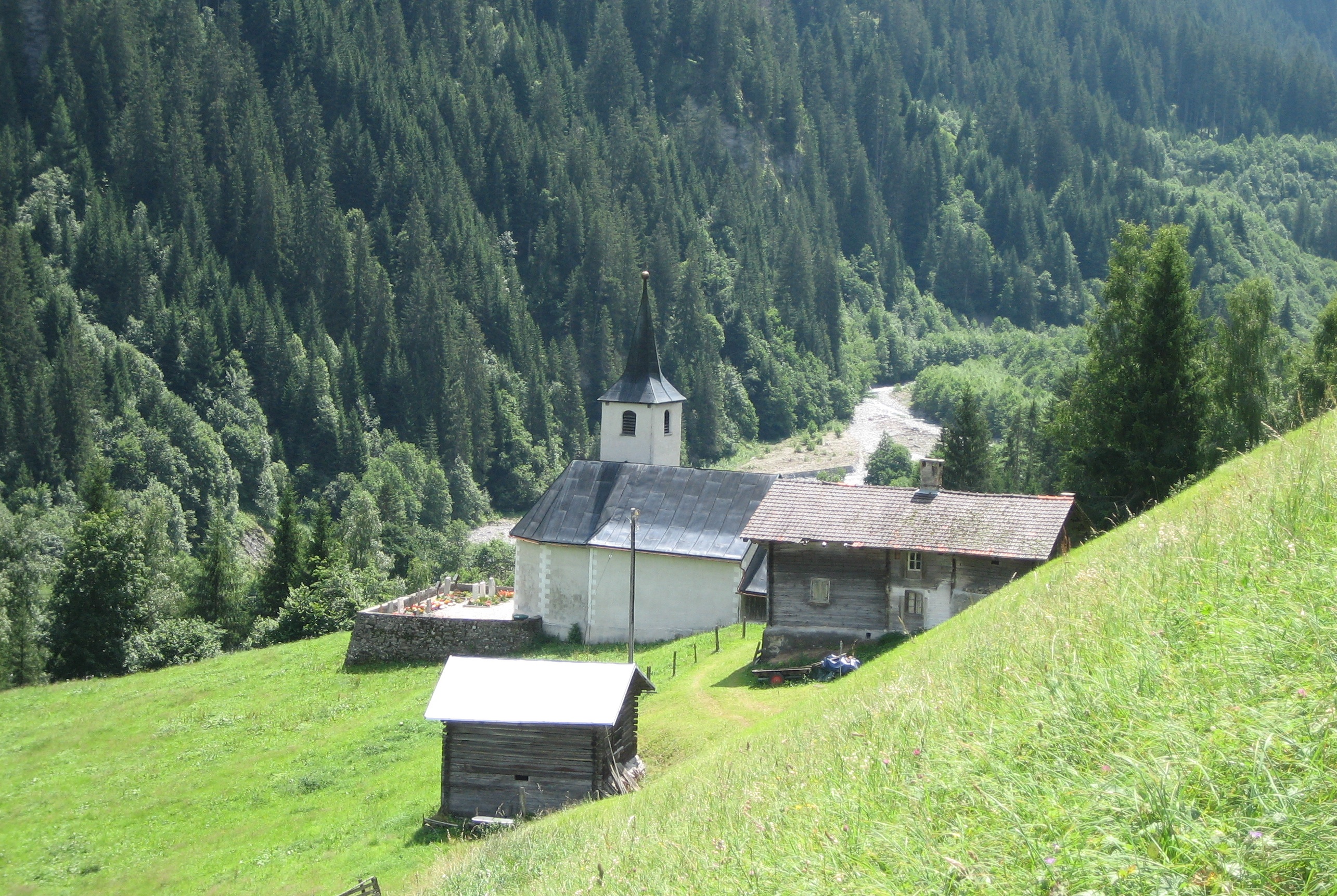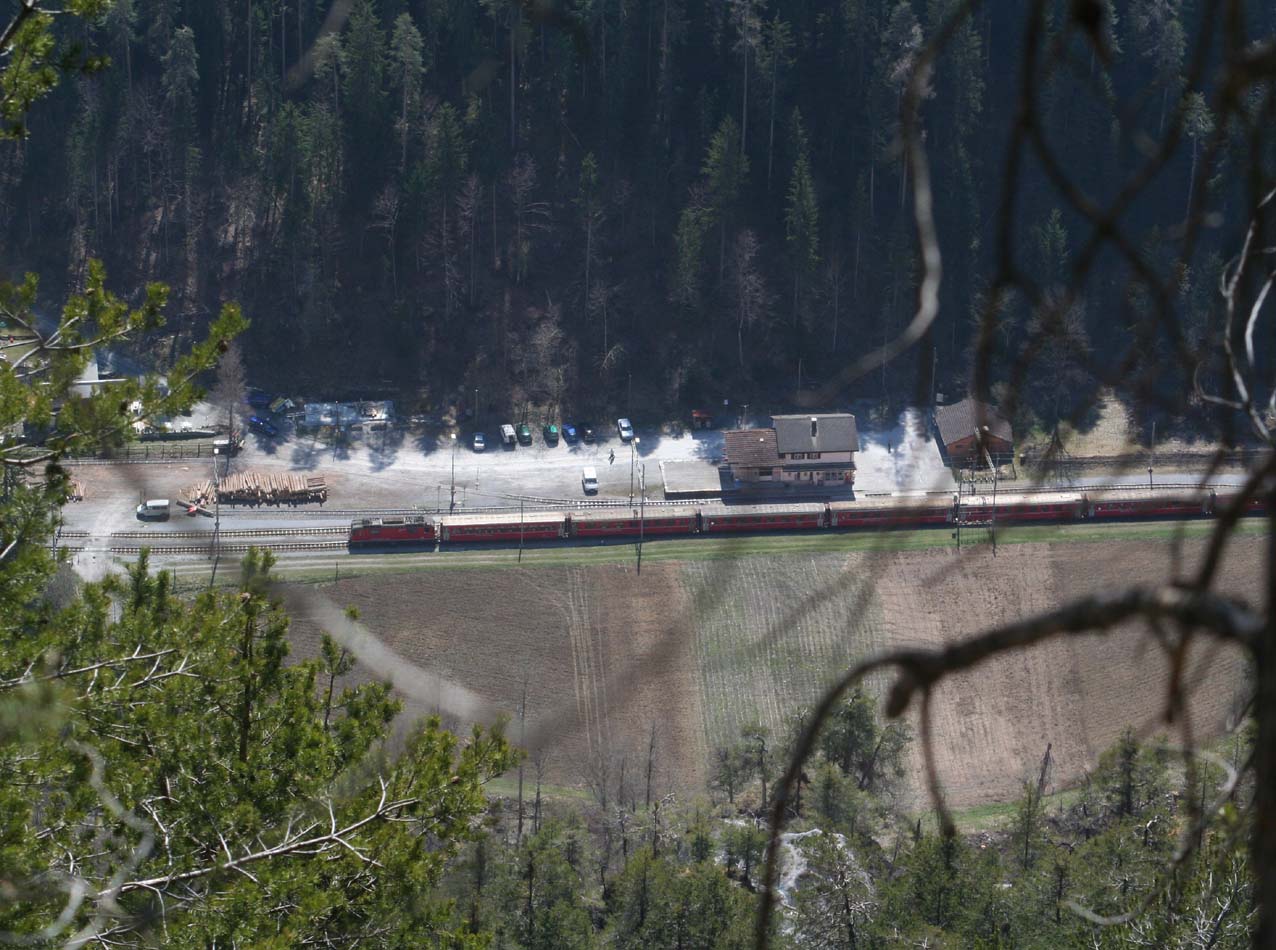Safiental on:
[Wikipedia]
[Google]
[Amazon]
Safiental is a
published by the Swiss Federal Statistical Office accessed 2 January 2013

 As of the 2004/09 survey, Safiental has an area of . Of this area, about 38.8% is used for agricultural purposes, while 31.1% is forested. Of the rest of the land, 1.2% is settled (buildings or roads) and 29.0% is unproductive land. In the 2004/09 survey a total of or about 0.4% of the total area was covered with buildings, an increase of over the 1984/85 amount.
Of the agricultural land, is used for orchards and vineyards, is fields and grasslands and consists of alpine grazing areas. Since 1984/85 the amount of agricultural land has decreased by . Over the same time period the amount of forested land has increased by . Rivers and lakes cover in the municipality.Regionalporträts 2017: Swiss Federal Statistical Office
As of the 2004/09 survey, Safiental has an area of . Of this area, about 38.8% is used for agricultural purposes, while 31.1% is forested. Of the rest of the land, 1.2% is settled (buildings or roads) and 29.0% is unproductive land. In the 2004/09 survey a total of or about 0.4% of the total area was covered with buildings, an increase of over the 1984/85 amount.
Of the agricultural land, is used for orchards and vineyards, is fields and grasslands and consists of alpine grazing areas. Since 1984/85 the amount of agricultural land has decreased by . Over the same time period the amount of forested land has increased by . Rivers and lakes cover in the municipality.Regionalporträts 2017: Swiss Federal Statistical Office
accessed 18 May 2017 The municipality contains the Safien valley, an
accessed 4 January 2013 It is located above the right side of the
Colors=
id:lightgrey value:gray(0.9)
id:darkgrey value:gray(0.8)
ImageSize = width:1100 height:500
PlotArea = top:10 left:100 bottom:90 right:100
Legend = columns:3 left:220 top:70 columnwidth:160
AlignBars = justify
DateFormat = x.y
Period = from:0 till:1800
TimeAxis = orientation:vertical
AlignBars = justify
ScaleMajor = gridcolor:darkgrey increment:400 start:0
ScaleMinor = gridcolor:lightgrey increment:80 start:0
Colors=
id:VA value:yellowgreen legend:Valendas
id:VE value:green legend:Versam
id:SA value:blue legend:Safien
id:TE value:red legend:Tenna
PlotData=
color:yellowgreen width:30 mark:(line,white) align:center
bar:1850 from: 0 till:555 text:"555" color:VA
bar:1860 from: 0 till:529 text:"529" color:VA
bar:1870 from: 0 till:492 text:"492" color:VA
bar:1880 from: 0 till:477 text:"477" color:VA
bar:1890 from: 0 till:463 text:"463" color:VA
bar:1900 from: 0 till:499 text:"499" color:VA
bar:1910 from: 0 till:478 text:"478" color:VA
bar:1920 from: 0 till:481 text:"481" color:VA
bar:1930 from: 0 till:437 text:"437" color:VA
bar:1940 from: 0 till:463 text:"463" color:VA
bar:1950 from: 0 till:441 text:"441" color:VA
bar:1960 from: 0 till:417 text:"417" color:VA
bar:1970 from: 0 till:353 text:"353" color:VA
bar:1980 from: 0 till:294 text:"294" color:VA
bar:1990 from: 0 till:292 text:"292" color:VA
bar:2000 from: 0 till:294 text:"294" color:VA
bar:1850 from: 555 till:951 text:"396" color:VE
bar:1860 from: 529 till:901 text:"372" color:VE
bar:1870 from: 492 till:840 text:"348" color:VE
bar:1880 from: 477 till:842 text:"365" color:VE
bar:1890 from: 463 till:853 text:"390" color:VE
bar:1900 from: 499 till:815 text:"316" color:VE
bar:1910 from: 478 till:805 text:"327" color:VE
bar:1920 from: 481 till:850 text:"369" color:VE
bar:1930 from: 437 till:775 text:"338" color:VE
bar:1940 from: 463 till:831 text:"368" color:VE
bar:1950 from: 441 till:795 text:"354" color:VE
bar:1960 from: 417 till:719 text:"302" color:VE
bar:1970 from: 353 till:628 text:"275" color:VE
bar:1980 from: 294 till:565 text:"271" color:VE
bar:1990 from: 292 till:561 text:"269" color:VE
bar:2000 from: 294 till:549 text:"255" color:VE
bar:1850 from: 951 till:1636 text:"685" color:SA
bar:1860 from: 901 till:1507 text:"606" color:SA
bar:1870 from: 840 till:1439 text:"599" color:SA
bar:1880 from: 842 till:1388 text:"546" color:SA
bar:1890 from: 853 till:1379 text:"526" color:SA
bar:1900 from: 815 till:1270 text:"455" color:SA
bar:1910 from: 805 till:1246 text:"441" color:SA
bar:1920 from: 850 till:1278 text:"428" color:SA
bar:1930 from: 775 till:1187 text:"412" color:SA
bar:1940 from: 831 till:1276 text:"445" color:SA
bar:1950 from: 795 till:1248 text:"453" color:SA
bar:1960 from: 719 till:1174 text:"455" color:SA
bar:1970 from: 628 till:974 text:"346" color:SA
bar:1980 from: 565 till:873 text:"308" color:SA
bar:1990 from: 561 till:904 text:"343" color:SA
bar:2000 from: 549 till:857 text:"308" color:SA
bar:1850 from: 1636 till:1798 text:"162" color:TE
bar:1860 from: 1507 till:1655 text:"148" color:TE
bar:1870 from: 1439 till:1585 text:"146" color:TE
bar:1880 from: 1388 till:1530 text:"142" color:TE
bar:1890 from: 1379 till:1532 text:"153" color:TE
bar:1900 from: 1270 till:1400 text:"130" color:TE
bar:1910 from: 1246 till:1384 text:"138" color:TE
bar:1920 from: 1278 till:1407 text:"129" color:TE
bar:1930 from: 1187 till:1322 text:"135" color:TE
bar:1940 from: 1276 till:1402 text:"126" color:TE
bar:1950 from: 1248 till:1389 text:"141" color:TE
bar:1960 from: 1174 till:1302 text:"128" color:TE
bar:1970 from: 974 till:1107 text:"133" color:TE
bar:1980 from: 873 till:994 text:"121" color:TE
bar:1990 from: 904 till:1000 text:"96" color:TE
bar:2000 from: 857 till:936 text:"79" color:TE
File:Türalihus Februar 2012.jpg, Türelihus in Valendas
File:Valendas Haus Joos.JPG, Joos House with Stables in Fraissa hamlet
File:Tenna Kirche.jpg,
 The municipality is served by two railway stations on the line of the
The municipality is served by two railway stations on the line of the
Official Website The Hour of Living
accessed 13 February 2013
municipality
A municipality is usually a single administrative division having corporate status and powers of self-government or jurisdiction as granted by national and regional laws to which it is subordinate.
The term ''municipality'' may also mean the ...
in the Surselva Region
Surselva Region is one of the eleven administrative districts in the canton of Graubünden in Switzerland. It was created on 1 January 2017 as part of a reorganization of the canton.canton
Canton may refer to:
Administrative division terminology
* Canton (administrative division), territorial/administrative division in some countries, notably Switzerland
* Township (Canada), known as ''canton'' in Canadian French
Arts and ente ...
of Graubünden in Switzerland
). Swiss law does not designate a ''capital'' as such, but the federal parliament and government are installed in Bern, while other federal institutions, such as the federal courts, are in other cities (Bellinzona, Lausanne, Luzern, Neuchâtel ...
. The municipalities of Valendas, Versam, Safien and Tenna merged on 1 January 2013 into the new municipality of Safiental.Amtliches Gemeindeverzeichnis der Schweizpublished by the Swiss Federal Statistical Office accessed 2 January 2013
History
Valendas is first mentioned in 765 as ''in Valendano''. Versam is first mentioned in 1050 as ''a valle Versamia''. Safien is first mentioned in 1219 as ''Stosavia''. Tenna is first mentioned in 1398 as ''Thena''. Formerly inhabited by Romansh speakers, it was settled by theWalser
The Walser people are the speakers of the Walser German dialects, a variety of Highest Alemannic.
They inhabit the region of the Alps of Switzerland and Liechtenstein, as well as the fringes of Italy and Austria.
The Walser people are named a ...
in the late 13th century. Population fell from 1,798 in 1850 to 994 in 1980 and has since stabilized just around 1,000.
Geography

 As of the 2004/09 survey, Safiental has an area of . Of this area, about 38.8% is used for agricultural purposes, while 31.1% is forested. Of the rest of the land, 1.2% is settled (buildings or roads) and 29.0% is unproductive land. In the 2004/09 survey a total of or about 0.4% of the total area was covered with buildings, an increase of over the 1984/85 amount.
Of the agricultural land, is used for orchards and vineyards, is fields and grasslands and consists of alpine grazing areas. Since 1984/85 the amount of agricultural land has decreased by . Over the same time period the amount of forested land has increased by . Rivers and lakes cover in the municipality.Regionalporträts 2017: Swiss Federal Statistical Office
As of the 2004/09 survey, Safiental has an area of . Of this area, about 38.8% is used for agricultural purposes, while 31.1% is forested. Of the rest of the land, 1.2% is settled (buildings or roads) and 29.0% is unproductive land. In the 2004/09 survey a total of or about 0.4% of the total area was covered with buildings, an increase of over the 1984/85 amount.
Of the agricultural land, is used for orchards and vineyards, is fields and grasslands and consists of alpine grazing areas. Since 1984/85 the amount of agricultural land has decreased by . Over the same time period the amount of forested land has increased by . Rivers and lakes cover in the municipality.Regionalporträts 2017: Swiss Federal Statistical Officeaccessed 18 May 2017 The municipality contains the Safien valley, an
alpine
Alpine may refer to any mountainous region. It may also refer to:
Places Europe
* Alps, a European mountain range
** Alpine states, which overlap with the European range
Australia
* Alpine, New South Wales, a Northern Village
* Alpine National P ...
valley of the Canton of Graubünden
The Grisons () or Graubünden,Names include:
*german: (Kanton) Graubünden ;
* Romansh:
** rm, label=Sursilvan, (Cantun) Grischun
** rm, label= Vallader, (Chantun) Grischun
** rm, label= Puter, (Chantun) Grischun
** rm, label= Surmiran, (Can ...
, branching off the Vorderrhein
The Vorderrhein (German; English: ''Anterior Rhine''; Sursilvan: ; Sutsilvan: ''Ragn Anteriur''; Rumantsch Grischun, Vallader, and Puter: ''Rain Anteriur''; Surmiran: ''Ragn anteriour'') is one of the two sources of the Rhine. Its catchment ar ...
valley.
Safien had an area, , of . Of this area, 45.6% is used for agricultural purposes, while 18.2% is forested. Of the rest of the land, 0.8% is settled (buildings or roads) and the remainder (35.4%) is non-productive (rivers, glaciers or mountains). Safien was the capital of the Safien sub-district of the Surselva district in the mid and upper Safien valley. The valley is drained by the Rabiusa river. The former municipality consists of the village of Safien-Platz (elevation: ) and scattered hamlets
A hamlet is a human settlement that is smaller than a town or village. Its size relative to a parish can depend on the administration and region. A hamlet may be considered to be a smaller settlement or subdivision or satellite entity to a lar ...
and single farm houses throughout the valley.
Tenna had an area, , of . Of this area, 45.1% is used for agricultural purposes, while 34% is forested. Of the rest of the land, 1.1% is settled (buildings or roads) and the remainder (19.8%) is non-productive (rivers, glaciers or mountains). It is a German-speaking collection of small settlements on a terrace above the west side of the Safien valley. It consists of the village of Tenna which is made up of the sections of Ausserberg, Mitte and Innerberg as well as the hamlets of Acla and Egschi along the valley road.
Valendas had an area, , of . Of this area, 21.6% is used for agricultural purposes, while 48.7% is forested. Of the rest of the land, 1.8% is settled (buildings or roads) and the remainder (27.9%) is non-productive (rivers, glaciers or mountains).Swiss Federal Statistical Officeaccessed 4 January 2013 It is located above the right side of the
Vorderrhein
The Vorderrhein (German; English: ''Anterior Rhine''; Sursilvan: ; Sutsilvan: ''Ragn Anteriur''; Rumantsch Grischun, Vallader, and Puter: ''Rain Anteriur''; Surmiran: ''Ragn anteriour'') is one of the two sources of the Rhine. Its catchment ar ...
canyon. It consists of the ''haufendorf'' village (an irregular, unplanned and quite closely packed village, built around a central square) of Valendas and the hamlets of Carrera, Brün, Dutjen and Turisch.
Versam had an area, , of . Of this area, 16.8% is used for agricultural purposes, while 70.6% is forested. Of the rest of the land, 2% is settled (buildings or roads) and the remainder (10.6%) is non-productive (rivers, glaciers or mountains). It is located above the Vorderrhein
The Vorderrhein (German; English: ''Anterior Rhine''; Sursilvan: ; Sutsilvan: ''Ragn Anteriur''; Rumantsch Grischun, Vallader, and Puter: ''Rain Anteriur''; Surmiran: ''Ragn anteriour'') is one of the two sources of the Rhine. Its catchment ar ...
canyon at the entrance to the Safien Valley. It consists of the linear village
Linearity is the property of a mathematical relationship ('' function'') that can be graphically represented as a straight line. Linearity is closely related to '' proportionality''. Examples in physics include rectilinear motion, the linear ...
of Versam and the hamlets of Versam-Station, Arezen, Calörtsch and Sculms.
Demographics
Safiental has a population () of . , 5.6% of the population are resident foreign nationals. Over the last 5 years (2010-2015) the population has changed at a rate of -5.49%. Thebirth rate
The birth rate for a given period is the total number of live human births per 1,000 population divided by the length of the period in years. The number of live births is normally taken from a universal registration system for births; populati ...
in the municipality, in 2015, was 15.6, while the death rate
Mortality rate, or death rate, is a measure of the number of deaths (in general, or due to a specific cause) in a particular population, scaled to the size of that population, per unit of time. Mortality rate is typically expressed in units of d ...
was 7.8 per thousand residents.
, children and teenagers (0–19 years old) make up 21.8% of the population, while adults (20–64 years old) are 54.7% of the population and seniors (over 64 years old) make up 23.5%. In 2015 there were 380 single residents, 406 people who were married or in a civil partnership, 55 widows or widowers and 55 divorced residents.
In 2015 there were 359 private households in Safiental with an average household size of 2.49 persons. In 2015 about 60.5% of all buildings in the municipality were single family homes, which is greater than the percentage in the canton (49.4%) and about the same as the percentage nationally (57.4%). In 2014 the rate of construction of new housing units per 1000 residents was 3.35. The vacancy rate for the municipality, , was 0.8%.
Historic Population
The historical population is given in the following chart:Heritage sites of national significance
The ''Türelihus'' and the ''Haus Joos'' with attached barn in Valendas and theSwiss Reformed
The Protestant Church in Switzerland (PCS), (EKS); french: Église évangélique réformée de Suisse (EERS); it, Chiesa evangelica riformata in Svizzera (CERiS); rm, Baselgia evangelica refurmada da la Svizra (BRRS) formerly named Federation o ...
Church in Tenna are listed as Swiss heritage sites of national significance.
The Türelihus (Türeli House) is located in the center of Valendas and is one of the most historically valuable houses in the village. The interior contains many of the original furnishings from the Renaissance
The Renaissance ( , ) , from , with the same meanings. is a period in European history marking the transition from the Middle Ages to modernity and covering the 15th and 16th centuries, characterized by an effort to revive and surpass ide ...
and Baroque
The Baroque (, ; ) is a style of architecture, music, dance, painting, sculpture, poetry, and other arts that flourished in Europe from the early 17th century until the 1750s. In the territories of the Spanish and Portuguese empires including ...
eras. The original building was constructed in 1485. In 1554 it was expanded, this expansion was known as the Renaissance phase, with a spiral staircase within a tower and a stable
A stable is a building in which livestock, especially horses, are kept. It most commonly means a building that is divided into separate stalls for individual animals and livestock. There are many different types of stables in use today; the ...
was added to the north side. In 1775 it was renovated in the baroque
The Baroque (, ; ) is a style of architecture, music, dance, painting, sculpture, poetry, and other arts that flourished in Europe from the early 17th century until the 1750s. In the territories of the Spanish and Portuguese empires including ...
style. The four-story building was abandoned for many years and had begun to decay. In 1994, the first attempt to renovate this building ended with only the addition of a temporary roof.
The oldest part of the ''Haus Joos'' may date to about 1300. The attached barn has a date of 1572 carved into it. However, the building is currently in poor condition and has not been used for a number of years.
Swiss Reformed
The Protestant Church in Switzerland (PCS), (EKS); french: Église évangélique réformée de Suisse (EERS); it, Chiesa evangelica riformata in Svizzera (CERiS); rm, Baselgia evangelica refurmada da la Svizra (BRRS) formerly named Federation o ...
Church in Tenna
Transport
 The municipality is served by two railway stations on the line of the
The municipality is served by two railway stations on the line of the Rhaetian Railway
The Rhaetian Railway (german: Rhätische Bahn; it, Ferrovia retica; rm, Viafier retica), abbreviated RhB, is a Swiss transport company that owns the largest network of all private railway operators in Switzerland. Headquartered in Chur, the Rh ...
that links Chur
, neighboring_municipalities= Arosa, Churwalden, Tschiertschen-Praden, Domat/Ems, Felsberg, Malix, Trimmis, Untervaz, Pfäfers
, twintowns = Bad Homburg (Germany), Cabourg (France), Mayrhofen (Austria), Mondorf-les-Bains (Luxe ...
and Disentis, these being Versam-Safien and Valendas-Sagogn. Versam-Safien station is located some lower than the village of Versam, and about to the north. To reach the village directly, a Postauto bus service provides a connection, which also serves Thalkirch
Safien is a former Municipalities of Switzerland, municipality in the district of Surselva (district), Surselva in the Switzerland, Swiss Cantons of Switzerland, canton of Graubünden. The municipalities of Valendas, Versam, Safien and Tenna, Swi ...
and Tenna. Similarly, Valendas-Sagogn station lies some below and distant from the village of Valendas.
In popular culture
The 2012 feature film ''The Hour of Living'' is largely set in Safiental, with especially ''Grossalp Piggamad'', as well as ''Z'hinderst, Bodaälpli'' and ''Alperschällihorn'' with its ''Gletscherseeli'' all serving as prominent locations.accessed 13 February 2013
References
{{Authority control Municipalities of Graubünden Cultural property of national significance in Graubünden